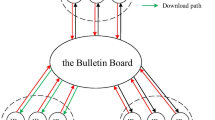Abstract
In the big data background, data privacy becomes more and more important when data leakage and other security events occur more frequently. As one of the key means of privacy protection, anonymous communication attracts large attention. Aiming at the problems such as low efficiency of message forwarding, high communication delay and abusing of anonymity, this paper presents an identity-based traceable anonymous communication model by adding a preprocessing phase, modifying the ciphertext structure and increasing the controllability of anonymity. Firstly, a new identity-based signature algorithm is proposed, and its security is proved via existential unforgeability against chosen-message attacks (EU-CMA). The signature algorithm is further applied to the anonymous communication model to implement the controllability of revocable anonymity. Secondly, by adding a preprocessing Setup phase, the operations of identifications distribution and user authentication are launched before the anonymous communication phase starts, and this practice significantly improves the efficiency of the anonymous communication model. Finally, by adding the hash value of the message and the user identification as the message authentication code, we design a new ciphertext structure, which can efficiently guarantee the integrity of the ciphertext. Performance analysis and simulation results show that the proposed anonymous communication model has high message forwarding efficiency and better security and controllability of anonymity.







Similar content being viewed by others
References
Boneh D, Boyen X (2004) Short signatures without random oracles. Theory and application of cryptographic techniques, pp 56–73
Bai X, Zhang Y, Niu X (2008) Traffic identification of tor and web-mix. In: Proceedings of 8th IEEE International Conference on Intelligent Systems Design and Applications, pp 548–551
Bauer K, Mccoy D, Grunwald D et al (2007) Low-resource routing attacks against tor. Workshop on privacy in the electronic society, pp 11–20
Chaum D (1981) Untraceable electronic mail, return addresses, and digital pseudonyms. Commun ACM 24(2):84–90
Chaum D (1988) The dining cryptographers problem: unconditional sender and recipient intractability. J Cryptol 1(1):65–75
Chaum D, Das D, Javani F et al (2017) cMix: mixing with minimal real-time asymmetric cryptographic operations. In: International conference on applied cryptography and network security, pp 557–578
Corrigangibbs H, Wolinsky DI, Ford B, et al (2013) Proactively accountable anonymous messaging in verdict. In: usenix security symposium, pp 147–162
Dingledine R, Mathewson N, Syverson P (2004) Tor: The second-generation onion router. J Franklin Inst 239(2):135–139
Elgamal T (1984) A public key cryptosystem and a signature scheme based on discrete logarithms. IEEE Trans Inf Theory 31(4):469–472
Hiller J, Pennekamp J, Dahlmanns M et al (2019) Tailoring onion routing to the internet of things: security and privacy in untrusted environments. In: International conference on network protocols, pp 1–12
Hoang NP, Pishva D (2014) Anonymous communication and its importance in social networking. In: The 16th IEEE International Conference on Advanced Communication Technology, pp 34–39
Jayaraman I, Panneerselvam AS (2020) A novel privacy preserving digital forensic readiness provable data possession technique for health care data in cloud. J Ambient Intell Human Comput. https://doi.org/10.1007/s12652-020-01931-1
Jiang L, Li T, Li X et al (2018) Anonymous communication via anonymous identity-based encryption and its application in IoT. Wirel Commun Mobile Comput. https://doi.org/10.1155/2018/6809796
Kwon A, Lazar D, Devadas S et al (2015) Riffle: an efficient communication system with strong anonymity. Privacy Enhanc Technol 2016(2):115–134
Li F, Ma J, Li J (2009) Distributed anonymous data perturbation method for privacy-preserving data mining. J Zhejiang Univ Sci A 10:952–963
Li Y, Wang G, Nie L (2018a) Distance metric optimization driven convolutional neural network for age invariant face recognition. Pattern Recogn 75:51–62
Li J, Zhang Y, Chen X et al (2018b) Secure attribute-based data sharing for resource-limited users in cloud computing. Comput Secur 72:1–12
Shamir A (1985) Identity-based cryptosystems and signature schemes. Lect Notes Comput 196(2):47–53
Silva P, Casaleiro R, Simões P et al (2020) Risk management and privacy violation detection in the PoSeID-on data privacy platform. SN Comput Sci 1:188
Wang X, Xu Z, Cai Z et al (2020) Novel temporal perturbation-based privacy-preserving mechanism for smart meters. Mobile Netw Appl 25:1548–1562
Yu B, Li H (2019) Anonymous authentication key agreement scheme with pairing-based cryptography for home-based multi-sensor Internet of Things. Int J Distrib Sensor Netw. https://doi.org/10.1177/1550147719879379
Acknowledgements
This study was funded by Foundation of National Natural Science Foundation of China (Grant Numbers: 62072273, 61771231), the Major Basic Research Project of Natural Science Foundation of Shandong Province of China (ZR2018ZC0438), Natural Science Shandong Province (Grant Numbers: ZR2016FM23, ZR2017MF010, ZR2017MF062), Key Research and Development Program of Shandong Province (NO. 2019GGX101025).
Author information
Authors and Affiliations
Corresponding author
Additional information
Publisher's Note
Springer Nature remains neutral with regard to jurisdictional claims in published maps and institutional affiliations.
Rights and permissions
About this article
Cite this article
Li, F., Liu, Z., Wang, Y. et al. Aitac: an identity-based traceable anonymous communication model. J Ambient Intell Human Comput 13, 1353–1362 (2022). https://doi.org/10.1007/s12652-020-02604-9
Received:
Accepted:
Published:
Issue Date:
DOI: https://doi.org/10.1007/s12652-020-02604-9




